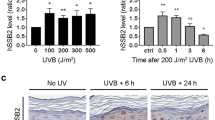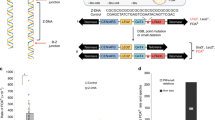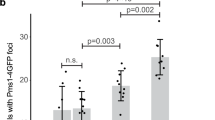Abstract
IN eukaryotes nucleotide excision repair of DNA damaged by ultraviolet radiation requires several gene products; defects in this process result in the cancer-prone syndrome xeroderma pigmento-sum (XP) in humans1,2. TheRAD2 gene is one of at least seven genes indispensable for excision repair in the yeast Saccharomyces cerevisiae2, and its encoded protein shares remarkable homology with the XP group-G gene product3. Here we overproduce the RAD2-encoded protein in S. cerevisiae, purify it to near homogeneity, and show that RAD2 protein in the presence of magnesium degrades circular single-stranded DNA. The RAD2 endonuclease is specific for single-stranded DNA as it does not act on doublestranded DNA. Given the absolute requirement for RAD2 in the incision step of excision repair, our findings directly implicate RAD2 protein and its human homologue XPG protein as a catalytic component that incises the damaged DNA strand during excision repair. Furthermore, our results indicate that eukaryotes probably employ two distinct endonuclease activities to mediate the dual incision at the damage site.
This is a preview of subscription content, access via your institution
Access options
Subscribe to this journal
Receive 51 print issues and online access
$199.00 per year
only $3.90 per issue
Buy this article
- Purchase on Springer Link
- Instant access to full article PDF
Prices may be subject to local taxes which are calculated during checkout
Similar content being viewed by others
References
Cleaver, J. E. & Kraemer, K. H. in The Metabolic Basis of Inherited Disease 6th edn (eds Scriver, C. R., Beaudet, A. L., Sly, W. S. & Valle, D.) 2949–2971 (McGraw-Hill, New York, 1989).
Prakash, S., Sung, P. & Prakash, L. A. Rev. Genet. 27, 33–70 (1993).
Scherly, D. et al. Nature 363, 182–185 (1993).
Kingsman, S. M. et al. Meth. Enzym. 152, 330–341 (1987).
Madura, K. & Prakash, S. J. Bact. 166, 914–933 (1986).
Bailly, V., Sommers, C. H., Sung, P., Prakash, L. & Prakash, S. Proc. natn. Acad. Sci. U.S.A. 89, 8273–8277 (1992).
Huang, J. C., Svoboda, D. L., Reardon, J. T. & Sancar, A. Proc. natn. Acad. Sci. U.S.A. 89, 3664–3668 (1992).
Svoboda, D. L., Taylor, J. S., Hearst, J. E. & Sancar, A. J. biol. Chem. 268, 1931–1936 (1993).
Sung, P., Reynolds, P., Prakash, L. & Prakash, S. J. biol. Chem. 268, 26391–26399 (1993).
Tomkinson, A. E., Bardwell, A. J., Bardwell, L., Tappe, N. J. & Friedberg, E. C. Nature 362, 860–862 (1993).
Orren, D. K. & Sancar, A. Proc. natn. Acad. Sci. U.S.A. 86, 5237–5241 (1989).
Sung, P., Prakash, L., Matson, S. W. & Prakash, S. Proc. natn. Acad. Sci. U.S.A. 84, 8951–8955 (1987).
Guzder, S. N., Sung, P., Prakash, L. & Prakash, S. Proc. natn. Acad. Sci. U.S.A. 90, 5433–5437 (1993).
Gulyas, K. D. & Donahue, T. F. Cell 69, 1031–1042 (1992).
Park, E. et al. Proc. natn. Acad. Sci. U.S.A. 89, 11416–11420 (1992).
Sung, P., Prakash, L. & Prakash, S. Nature 355, 743–745 (1992).
Author information
Authors and Affiliations
Rights and permissions
About this article
Cite this article
Habraken, Y., Sung, P., Prakash, L. et al. Yeast excision repair gene RAD2 encodes a single-stranded DNA endonuclease. Nature 366, 365–368 (1993). https://doi.org/10.1038/366365a0
Received:
Accepted:
Issue Date:
DOI: https://doi.org/10.1038/366365a0
This article is cited by
-
Rice exonuclease-1 homologue, OsEXO1, that interacts with DNA polymerase λ and RPA subunit proteins, is involved in cell proliferation
Plant Molecular Biology (2008)
-
Degradation of DNA during the autolysis of Saccharomyces cerevisiae
Journal of Industrial Microbiology & Biotechnology (2003)
-
The genetics of the repair of 5-azacytidine-mediated DNA damage in the fission yeastSchizosaccharomyces pombe
Molecular and General Genetics MGG (1996)
-
Saccharomyces cerevisiae DNA repair processes: an update
Molecular and Cellular Biochemistry (1996)
-
Activity of single-stranded DNA endonucleases in mung bean is associated with cell division
Plant Molecular Biology (1995)
Comments
By submitting a comment you agree to abide by our Terms and Community Guidelines. If you find something abusive or that does not comply with our terms or guidelines please flag it as inappropriate.



